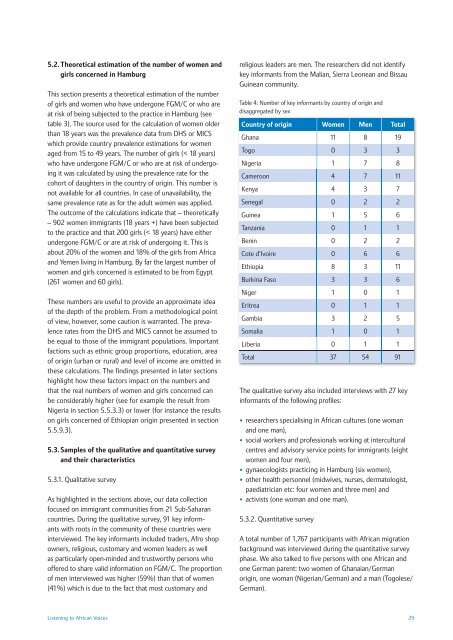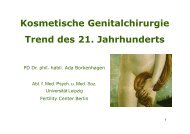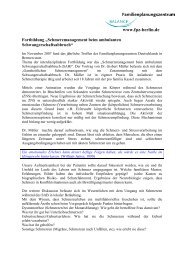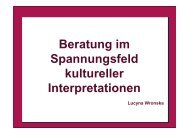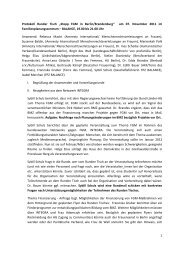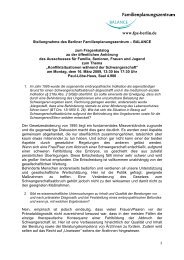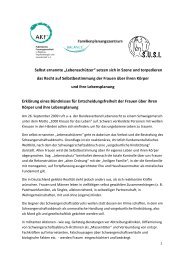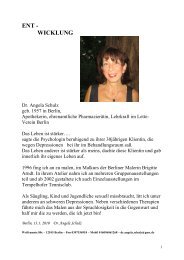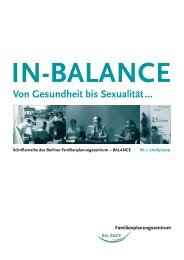Listening to African Voices - FPZ
Listening to African Voices - FPZ
Listening to African Voices - FPZ
You also want an ePaper? Increase the reach of your titles
YUMPU automatically turns print PDFs into web optimized ePapers that Google loves.
5.2. Theoretical estimation of the number of women andgirls concerned in HamburgThis section presents a theoretical estimation of the numberof girls and women who have undergone FGM/C or who areat risk of being subjected <strong>to</strong> the practice in Hamburg (seetable 3). The source used for the calculation of women olderthan 18 years was the prevalence data from DHS or MICSwhich provide country prevalence estimations for womenaged from 15 <strong>to</strong> 49 years. The number of girls (< 18 years)who have undergone FGM/C or who are at risk of undergoingit was calculated by using the prevalence rate for thecohort of daughters in the country of origin. This number isnot available for all countries. In case of unavailability, thesame prevalence rate as for the adult women was applied.The outcome of the calculations indicate that – theoretically– 902 women immigrants (18 years +) have been subjected<strong>to</strong> the practice and that 200 girls (< 18 years) have eitherundergone FGM/C or are at risk of undergoing it. This isabout 20% of the women and 18% of the girls from Africaand Yemen living in Hamburg. By far the largest number ofwomen and girls concerned is estimated <strong>to</strong> be from Egypt(261 women and 60 girls).These numbers are useful <strong>to</strong> provide an approximate ideaof the depth of the problem. From a methodological poin<strong>to</strong>f view, however, some caution is warranted. The prevalencerates from the DHS and MICS cannot be assumed <strong>to</strong>be equal <strong>to</strong> those of the immigrant populations. Importantfactions such as ethnic group proportions, education, areaof origin (urban or rural) and level of income are omitted inthese calculations. The fi ndings presented in later sectionshighlight how these fac<strong>to</strong>rs impact on the numbers andthat the real numbers of women and girls concerned canbe considerably higher (see for example the result fromNigeria in section 5.5.3.3) or lower (for instance the resultson girls concerned of Ethiopian origin presented in section5.5.9.3).5.3. Samples of the qualitative and quantitative surveyand their characteristics5.3.1. Qualitative surveyAs highlighted in the sections above, our data collectionfocused on immigrant communities from 21 Sub-Saharancountries. During the qualitative survey, 91 key informantswith roots in the community of these countries wereinterviewed. The key informants included traders, Afro shopowners, religious, cus<strong>to</strong>mary and women leaders as wellas particularly open-minded and trustworthy persons whooffered <strong>to</strong> share valid information on FGM/C. The proportionof men interviewed was higher (59%) than that of women(41%) which is due <strong>to</strong> the fact that most cus<strong>to</strong>mary andreligious leaders are men. The researchers did not identifykey informants from the Malian, Sierra Leonean and BissauGuinean community.Table 4: Number of key informants by country of origin anddisaggregated by sexCountry of origin Women Men TotalGhana 11 8 19Togo 0 3 3Nigeria 1 7 8Cameroon 4 7 11Kenya 4 3 7Senegal 0 2 2Guinea 1 5 6Tanzania 0 1 1Benin 0 2 2Cote d’Ivoire 0 6 6Ethiopia 8 3 11Burkina Faso 3 3 6Niger 1 0 1Eritrea 0 1 1Gambia 3 2 5Somalia 1 0 1Liberia 0 1 1Total 37 54 91The qualitative survey also included interviews with 27 keyinformants of the following profiles:• researchers specialising in <strong>African</strong> cultures (one womanand one man),• social workers and professionals working at interculturalcentres and advisory service points for immigrants (eightwomen and four men),• gynaecologists practicing in Hamburg (six women),• other health personnel (midwives, nurses, derma<strong>to</strong>logist,paediatrician etc: four women and three men) and• activists (one woman and one man).5.3.2. Quantitative surveyA <strong>to</strong>tal number of 1,767 participants with <strong>African</strong> migrationbackground was interviewed during the quantitative surveyphase. We also talked <strong>to</strong> five persons with one <strong>African</strong> andone German parent: two women of Ghanaian/Germanorigin, one woman (Nigerian/German) and a man (Togolese/German).<strong>Listening</strong> <strong>to</strong> <strong>African</strong> <strong>Voices</strong> 29


